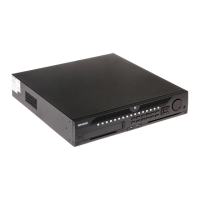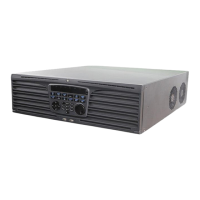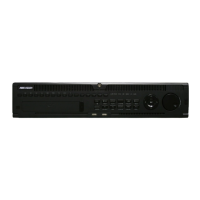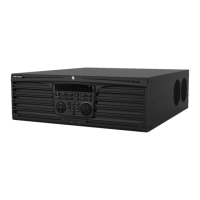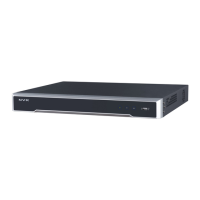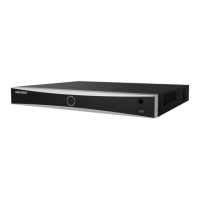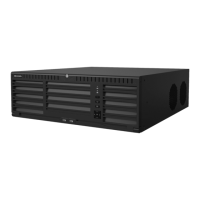
Do you have a question about the HIKVISION DS-96128NI-I16 and is the answer not in the manual?
| Audio system | 2-way |
|---|---|
| Input bandwidth | 576 Mbit/s |
| Output bandwidth | 512 Mbit/s |
| Maximum frame rate | 30 fps |
| Maximum resolution | 4096 x 2160 pixels |
| Alarm input channels | 16 |
| Video input channels | 128 channels |
| Alarm output channels | 8 |
| Supported resolutions | 4096 x 2160, 3840 x 2160, 2560 x 1440, 1920 x 1080, 1600 x 1200, 1280 x 1024, 1280 x 720, 1024 x 768 |
| Video formats supported | H.264, H.264+, H.265, H.265+, MPEG4 |
| RAID levels | 0, 1, 5, 6, 10 |
| HDD capacity | - GB |
| RAID support | Yes |
| HDD interface | SATA |
| Maximum storage capacity | 160 TB |
| Number of HDDs installed | 0 |
| eSATA ports quantity | 1 |
| USB 2.0 ports quantity | 2 |
| Ethernet LAN data rates | 10, 100, 1000 Mbit/s |
| Ethernet LAN (RJ-45) ports | 4 |
| Supported network protocols | IPv6, HTTPS, UPnP, SNMP, NTP, SADP, SMTP, NFS, iSCSI, PPPoE, DDNS |
| Wi-Fi | No |
| AC input voltage | 100 - 240 V |
| AC input frequency | 50 - 60 Hz |
| Power consumption (typical) | 140 W |
| Operating temperature (T-T) | 0 - 50 °C |
| Operating relative humidity (H-H) | 10 - 90 % |
| Product color | Black |
| Display type | LCD |
| Display diagonal | 7 \ |
| Depth | 494 mm |
|---|---|
| Width | 442 mm |
| Height | 146 mm |
| Weight | 16000 g |
Describes the physical buttons and indicators on the front panel of the NVR for basic operation and status indication.
Explains how to use a USB mouse and the on-screen keyboard for device navigation and input.
Details the various ports and connectors available on the rear panel for system integration and expansion.
Provides step-by-step instructions for safely starting up, shutting down, and rebooting the Network Video Recorder.
Guides users through the initial device activation process, including setting a strong administrator password.
Explains how to configure and use the unlock pattern and standard login methods for accessing the NVR.
Details the use of the setup wizard for basic configuration of essential NVR settings like date, time, and network.
Describes the procedures for logging into and out of the NVR system, including account protection measures.
Covers the process of activating, searching, and adding IP cameras to the NVR for video surveillance.
Introduces the live view function, explaining its purpose and the meaning of on-screen icons for status monitoring.
Details various operations within live view mode, such as single/multi-screen display, auto-switch, and using auxiliary monitors.
Explains how to customize live view settings, including video output, dwell time, and audio options for optimal viewing.
Describes how to configure channel-zero encoding to reduce bandwidth requirements for remote viewing without compromising image quality.
Guides users on how to set PTZ parameters before controlling PTZ-enabled cameras for optimal operation.
Details how to customize and call PTZ presets, patrols, and patterns for automated camera movements and surveillance.
Explains how to configure parameters affecting image quality, stream type, resolution, and encoding for recording.
Guides users on setting up a schedule for automatic recording based on time or specific events like motion detection.
Details how to configure motion detection, set detection areas, and define alarm response actions for recording.
Explains how to configure recording or capture triggered by external alarm inputs, including setting up alarm response actions.
Describes how to manually start and stop recording or continuous capture, which takes priority over scheduled recordings.
Guides users on configuring recording or capture schedules specifically for holidays, allowing different plans.
Explains how to enable redundant recording and capture to save data on both R/W and redundant HDDs for enhanced safety and reliability.
Details how to group HDDs to save recorded files and captured pictures onto specific HDD groups for organized storage.
Covers methods to protect recorded files by locking them or setting HDD properties to read-only to prevent overwriting.
Provides instructions on how to play back recorded video files using various search methods like instant, normal, and smart playback.
Details additional playback features such as frame-by-frame playback, thumbnail view, fast view, digital zoom, and file management.
Guides users on how to export record files quickly or through normal video/picture and event searches to backup devices.
Explains how to manage backup devices like USB flash drives and HDDs, including creating folders and formatting.
Describes how to set up a hot spare device system to ensure continuous operation and data reliability in case of device failure.
Details how to configure motion detection, set detection areas, and define arming schedules for alarm handling.
Explains how to configure handling actions for external sensor alarms, including trigger channels, arming schedules, and PTZ linkage.
Guides users on setting up alarms and response actions for detecting video loss on camera channels.
Details how to configure video tampering detection, set sensitivity, and define alarm response actions for tampering events.
Explains how to configure handling actions for various system exceptions like HDD errors, network disconnection, and illegal logins.
Describes how to configure various alarm response actions such as event hint display, full-screen monitoring, audible warnings, and email notifications.
Explains how to manually trigger or clear alarm outputs for testing or specific operational needs.
Guides users on configuring face detection, setting rules, and defining alarm response actions for detected faces.
Details how to configure vehicle detection for road traffic monitoring, including license plate capture and alarm notifications.
Explains how to set up line crossing detection, define virtual lines, directions, and sensitivity for monitoring intrusions.
Guides users on configuring intrusion detection by setting thresholds, sensitivity, and drawing detection regions for unauthorized entry alerts.
Details how to configure region entrance detection to identify people or vehicles entering a defined virtual area and trigger alarms.
Explains how to search for detected face pictures and play associated video files based on specified conditions.
Guides users on searching for suspicious behaviors detected by VCA, such as line crossing or intrusion, based on time and type.
Details how to search for captured vehicle plate pictures and related information using conditions like time, country, and plate number.
Explains how to use the people counting function to analyze entry/exit data and generate reports for customer flow analysis.
Describes how to use the heat map function to visualize customer dwell times and popular areas within a configured zone.
Guides users through configuring general network settings like working mode, NIC type, IP address, and DNS server for network connectivity.
Details advanced network configurations including DDNS, NTP server, SNMP, more settings, HTTPS, Email, and NAT for remote access and system management.
Explains how to check network traffic for real-time information on linking status, MTU, and sending/receiving rates.
Guides users on configuring network detection to obtain connection status, including network delay, packet loss, and exporting network packets.
Explains how to enable RAID and configure disk arrays using one-touch or manual methods for data redundancy and storage.
Details the process of automatically or manually rebuilding a RAID array when a disk fails to restore data security and reliability.
Guides users on how to delete a configured RAID array, which will erase all data on the disk.
Explains how to view firmware information and set the background task speed for system maintenance.
Guides users through the essential process of initializing newly installed hard disk drives before they can be used by the NVR.
Explains how to add and configure NAS or IP SAN disks to be used as network HDDs for expanded storage capacity.
Details how to configure external eSATA devices for record/capture or export functions, managing them within the NVR.
Guides users on managing HDDs in groups, setting HDD properties (read-only, redundancy), and configuring quota modes for storage allocation.
Explains how to configure allocated quotas for each camera to manage the storage of recorded files or captured pictures.
Details how to clone HDD data to an eSATA disk manually, typically when an HDD is detected as abnormal.
Guides users on checking the status of installed HDDs to perform timely maintenance and identify potential failures.
Explains how to use S.M.A.R.T. and Bad Sector Detection techniques to monitor HDD reliability and anticipate failures.
Guides users on configuring alarms for HDD errors (uninitialized or abnormal status) and setting response actions.
Explains how to configure OSD settings for cameras, including date/time, camera name, and display modes.
Guides users on configuring privacy mask zones to prevent specific surveillance areas from being viewed or recorded.
Details how to customize image parameters like brightness, contrast, and saturation for live view and recording quality.
Explains how to view detailed system information about the NVR, including device, camera, record, alarm, network, and HDD status.
Guides users on searching, viewing, and exporting log files that store NVR operations, alarms, and exceptions for auditing and troubleshooting.
Details how to export and import IP camera configuration information for backup or transferring settings to multiple devices.
Explains how to export NVR configuration files for backup and import them to multiple NVR devices for efficient setup.
Guides users on upgrading the NVR system firmware using local backup devices or remote FTP servers for performance improvements and new features.
Explains how to restore the NVR to factory default settings, including options for resetting all parameters or only specific ones.
Details how to configure general system settings like language, resolution, time zone, and mouse pointer speed for display and input.
Guides users on configuring Daylight Saving Time (DST) settings, either automatically or manually, to ensure accurate timekeeping.
Explains how to configure additional system settings such as device name, auto-logout, and HDMI/VGA output modes for system customization.
Guides users on adding, deleting, and editing user accounts, managing their permissions and security settings for access control.
Provides detailed technical specifications for different NVR models, covering hardware, software, and performance capabilities.
Offers a glossary of technical terms and acronyms used throughout the manual to aid understanding of NVR functionalities.
Offers solutions to common issues users might encounter, such as no image display, audible warnings, or camera connectivity problems.
Lists compatible Hikvision and third-party IP cameras, including their models, versions, and supported features for integration.



